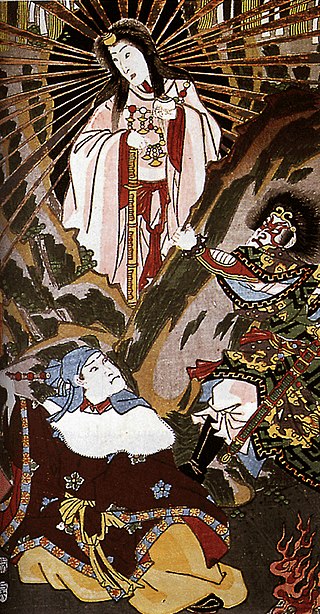
Amaterasu Ōmikami, often called Amaterasu for short, also known as Ōhirume no Muchi no Kami (大日孁貴神), is the goddess of the sun in Japanese mythology. Often considered the chief deity (kami) of the Shinto pantheon, she is also portrayed in Japan's earliest literary texts, the Kojiki and the Nihon Shoki, as the ruler of the heavenly realm Takamagahara and as the mythical ancestress of the Imperial House of Japan via her grandson Ninigi. Along with two of her siblings she ranks as one of the "Three Precious Children", the three most important offspring of the creator god Izanagi.
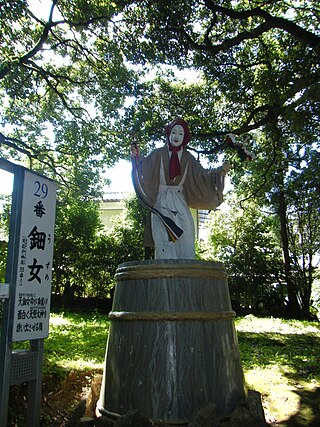
Ame-no-Uzume-no-Mikoto is the goddess of dawn, mirth, meditation, revelry and the arts in the Shinto religion of Japan, and the wife of fellow-god Sarutahiko Ōkami. She famously helped draw out the missing sun deity, Amaterasu Omikami, when she had hidden herself in a cave. Her name can also be pronounced as Ama-no-Uzume-no-Mikoto. She is also known as Ōmiyanome-no-Ōkami, an inari kami possibly due to her relationship with her husband. She is also known as Ame-no-Uzume-no-Mikoto, The Great Persuader, and The Heavenly Alarming Female. She is depicted in kyōgen farce as Okame, a woman who revels in her sensuality.
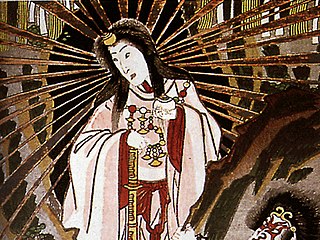
Japanese mythology is a collection of traditional stories, folktales, and beliefs that emerged in the islands of the Japanese archipelago. Shinto traditions are the cornerstones of Japanese mythology. The history of thousands of years of contact with Chinese and various Indian myths are also key influences in Japanese religious belief.

The Three Sacred Treasures are the imperial regalia of Japan and consist of the sword Kusanagi no Tsurugi (草薙劍), the mirror Yata no Kagami (八咫鏡), and the jewel Yasakani no Magatama (八尺瓊勾玉). They represent the three primary virtues: valour, wisdom, and benevolence. The actual historical status of these legendary treasures is unknown as they are intentionally kept from public view to symbolize authority.
Ōgetsu-hime, commonly known as Ukemochi, the daughter of the Shinto deities Izanagi and Izanami, is a goddess of food in the Shinto religion of Japan. In some differing interpretations, Ukemochi is referred to as both male and female. When shown in other forms, Ukemochi takes the shape of a fox. Ōgetsu-hime is married to Hayamato, who is the son of Toshigami through his wife Amechikarumizu-hime (天知迦流美豆比売) in the Kojiki, making Hayamato her great-grandnephew through her brother Ōyamatsumi. In some legends, Ukemochi is also married to Inari and in others, she is Inari.
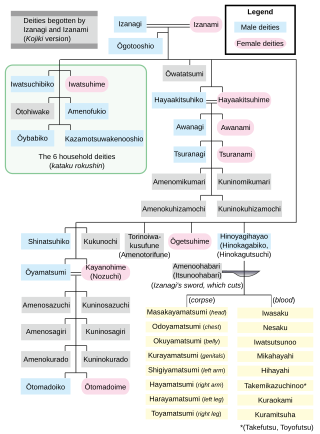
Ōyama-tsumi or Ohoyama-tsumi, also Ōyama-tsumi-mi'oya-no-mikoto (大山祇御祖命), is a god of mountains, sea, and war in Japanese mythology. He is an elder brother of Amaterasu and Susanoo. His other names are Watashi-no-Ōkami (和多志大神) and Sakatoke (酒解神).
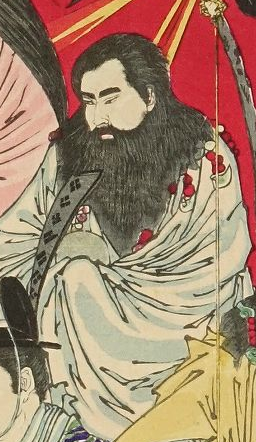
Ninigi-no-Mikoto is a deity in Japanese mythology. Grandson of the sun goddess Amaterasu, Ninigi is regarded according to Japanese mythology as the great-grandfather of Japan’s first emperor, Emperor Jimmu. The three sacred treasures brought with Ninigi from Heaven and divine ancestry established the Japanese Imperial Family.

Ugayafukiaezu no Mikoto (鵜葺草葺不合命) is a Shinto kami, and is in Japanese mythology, the father of Japan's first Emperor, Emperor Jimmu.
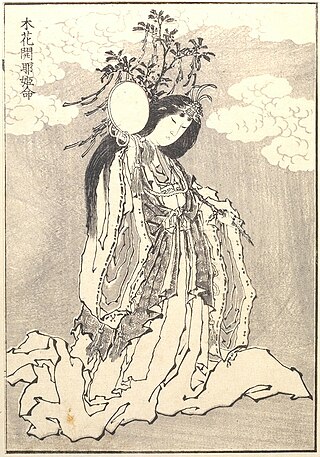
Konohanasakuya-hime is the goddess of Mount Fuji and all volcanoes in Japanese mythology; she is also the blossom-princess and symbol of delicate earthly life. She is often considered an avatar of Japanese life, especially since her symbol is the sakura.

Ōkuninushi, also known as Ō(a)namuchi or Ō(a)namochi among other variants, is a kami in Japanese mythology. He is one of the central deities in the cycle of myths recorded in the Kojiki and the Nihon Shoki alongside the sun goddess Amaterasu and her brother, the wild god Susanoo, who is reckoned to be either Ōkuninushi's distant ancestor or father. In these texts, Ōkuninushi (Ōnamuchi) is portrayed as the head of the kunitsukami, the gods of the earth, and the original ruler of the terrestrial world, named Ashihara no Nakatsukuni. When the heavenly deities (amatsukami) headed by Amaterasu demanded that he relinquish his rule over the land, Ōkuninushi agreed to their terms and withdrew into the unseen world, which was given to him to rule over in exchange. Amaterasu's grandson Ninigi then came down from heaven to govern Ashihara no Nakatsukuni and eventually became the ancestor of the Japanese imperial line.
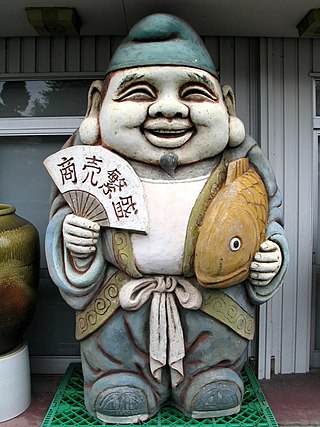
Shinto is frequently a theme in Japanese popular culture, including film, manga, anime, and video games. Shinto has influenced Japanese culture and history and as such greatly affects pop culture in modern Japan.

Sarutahiko Ōkami is a deity of the Japanese religion of Shinto; he is the leader of the earthly kami. Norito also mentions him with the title Daimyōjin instead of Ōkami. Sarutahiko Ōkami was the head of the kunitsukami and in the Jinnō Shōtōki is said to have been the ancestor of Otanomikoto.

Amenooshihomimi (天忍穗耳尊,天之忍穂耳命) or Oshihomimi for short, is the first son of Amaterasu.
Ame no Hohi is a male deity and the second son of sun goddess Amaterasu in Japanese mythology. Izumo no Kuni no Miyatsuko or the historical rulers of Izumo and modern heads of Izumo-taisha and Izumo-taishakyo descend from him.
Takamimusubi is a god of agriculture in Japanese mythology, who was the second of the first beings to come into existence.

Futodama is a god in Japanese mythology, claimed to be the ancestor of Inbe clan, whose characteristics are believed to reflect the functions of the clan as court ritualists.
This is a family tree of Japanese deities. It covers early emperors until Emperor Ojin, the first definitively known historical emperor, see family tree of Japanese monarchs for a continuation of the royal line into historical times.
Haniyasu-hiko and Haniyasu-hime are two gods of earth, clay, and pottery in Japanese mythology. The two of them are collectively known by the name Haniyasu no kami. The pair are considered husband and wife as well as siblings. They are also viewed as having the same divine virtues and powers.

Sarutahiko Shrine (猿田彦神社) is a shinto shrine in Ise, Mie. located close to Ise Grand Shrine. It is a beppyo shrine and a Hokora in the modern system of ranked shinto shrines.












